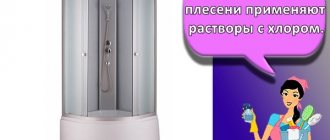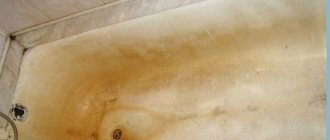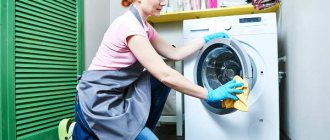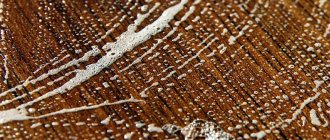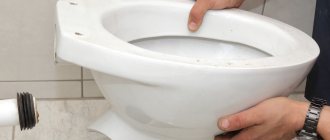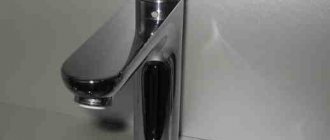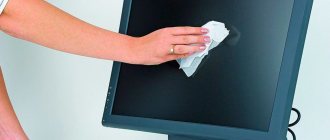A toilet room and toilet, shining with cleanliness, is the dream of every housewife.
This result can be achieved if you strictly follow the cleaning schedule and select the right equipment and means for washing and disinfection.
The advice of experienced housewives and professional cleaners will help with this. You will find all the most important things about cleaning the toilet in this article.
Rules for cleaning the bathroom in the house
Before you begin the fight against pathogenic microbes, plaque and unpleasant odors in the toilet, you need to audit your cleaning equipment and become familiar with the sequence of cleaning surfaces for an impeccable result.
Necessary equipment
To clean the problem area you will need:
rags, napkins, sponges, brushes for various surfaces;- toilet brush;
- mop for cleaning the floor;
- containers for cleaning solutions and clean water (basins, buckets);
- detergents and disinfectants;
- spray;
- rubber gloves, respirator or mask.
clean the toilet in clothes specially designated for this.
After manipulation, equipment must be disinfected to prevent the spread of microorganisms: rinse thoroughly, treat with a special agent, and dry.
How to wash?
When cleaning the bathroom, you should follow a certain order so as not to do the same job twice.
Step by step steps:
- Wear work clothes and protective equipment.
- Take out the trash, remove rugs and anything unnecessary.
- Clean and disinfect walls, doors, cabinets, mirrors, shelves, windows.
- Remove water from the toilet.
- Wash and treat its bowl, outer walls and components with a chlorine-containing solution.
- Wash the floor and wipe it dry.
Housewives often use a protective apron made of oilcloth to clean the toilet to avoid getting germs and aggressive cleaning agents on their clothes.
Let's start cleaning
The procedure is as follows:
- Remove all unnecessary items near the toilet to avoid staining them. Do not place cleaning products and tools on the tank, as they may fall inside.
- If you plan to clean the toilet bowl, use a plunger.
- It is better that the water used to remove impurities is warm rather than cold. This will increase the efficiency of any product.
- Apply Domestos or any other cleaning product and wait about 20-30 minutes.
- While the product inside begins to work, you can carry out external cleaning: wipe the handle, drain tank, lid.
- The seat needs to be washed and dried.
- You can clean the hinges that attach the seat to the base using a brush.
- Now you can return to the inside where the product worked. Use a brush to remove dirt, then drain the water and go over the entire area with this tool, removing any remaining dirt.
- It is better to dry the brush so that it does not spread an unpleasant odor throughout the toilet.
Selecting a Cleaning Product
Manufacturers of household chemicals for home cleaning offer a variety of concentrates, gels and liquids for toilet bowls.
To make the right choice, it is necessary to identify the main problem of contamination and pay attention to the composition of the product:
- Surfactant – removes common stains;
- acids - dissolve uric and limescale deposits;
- alkali – fights rust and organic contaminants;
- chlorine – bleaches, eliminates odors and fights microorganisms.
Fragrances in cleaning solutions are an optional component; they deodorize the problematic surface and mask the pungent odor of household chemicals.
Popular toilet cleaning products:
- Bref Power Gel 6 in 1 . A universal concentrated product that fights rust, limescale and organic dirt, and disinfects surfaces.
- Comet 7 days of cleanliness . Multifunctional spray effectively removes all types of plaque in the toilet and protects against microorganisms.
- Dressing Duckling Super power visible effect . The gel in a container with a convenient spout penetrates into hard-to-reach places, copes with all known types of contaminants, and destroys pathogenic microbes.
Housewives note that universal products reduce cleaning time and allow you to save money. An overview of effective toilet cleaners is presented in this material.
Household chemicals
Special effective products for making plumbing fixtures white, namely for cleaning the toilet, are purchased in hardware departments or in household chemical stores. The range includes:
- white;
- powders;
- liquids;
- gels;
- creams;
- tablets for the tank.
White
To treat with whiteness, you need to prepare the device: drain all the water from the bowl and neck. Pour 1 liter of the substance inside, close the toilet lid and leave overnight.
Powders
The loose abrasive base and disinfecting properties of Komet allow you to get rid of plaque and rust in a short time. After pouring the mixture onto the dirty places, you need to rub the surface, let the substance work for 15-20 minutes and press the drain button. Doesn't work well with old stains.
Surface cleaning
Cleaning the bathroom must be done in a certain sequence ; detergents should be selected depending on the material.
Walls
The side surfaces of the toilet are usually tiled. For effective cleaning at home, you can use folk recipes using budget components.
Step-by-step instruction:
Prepare a solution of water (1 liter) and table vinegar (200 ml).- Treat the tiles with the prepared liquid from a spray bottle.
- Dilute crushed chalk in warm water to a paste consistency.
- Apply to surface with a sponge.
- Rinse off with a cloth dampened in clean water.
- Wipe dry.
If you add 100 g of baking soda to the chalk slurry, you can restore the whiteness of the seams between the tiles.
Toilet and its components
You should not limit yourself to cleaning the plumbing bowl. It is necessary to wash the interior, exterior and components.
For perfect cleanliness, the toilet lid requires daily cleaning with a sponge using a soap solution. It is necessary to wash the tank and drain handle . A universal washing liquid is suitable for this; you can prepare a soda solution.
All parts must be thoroughly cleaned with a sponge, then wiped with a cloth soaked in water and dried. Lastly, disinfection is carried out.
To quickly clean the bowl, experienced housewives use a solution of hydrogen peroxide and ammonia in a ratio of 9:1.
Rugs
Before cleaning, they must be collected and shaken well to remove dust and debris.
The label with the manufacturer's recommendations will tell you whether to wash or clean the product . The final stage should be drying in the fresh air.
If the rugs are not dried well, mold may appear on them under the influence of moisture, which will be more difficult to get rid of than everyday dirt and microorganisms.
Floor
The last stage of general cleaning in the toilet room. The goal is to clean the surface of contaminants and disinfect it.
The first time it is necessary to treat it with a detergent, the second time you need to add a small amount of an industrial solution based on bleach (sodium hypochlorite) to the water or prepare a homemade mixture with bleach.
It is often advised to add ethyl alcohol to water, but the component is ineffective in this situation. A 9% vinegar solution will bring much more benefit .
Cleaning the floor should start from the baseboards, continue from the walls to the center and then to the exit.
Toilet cleaning algorithm
The instructions for bleaching a toilet bowl are simple. When using different tools, the general algorithm remains the same.
- Water is scooped out of the bowl and collected in a bucket. Only a few special products suitable for cleaning bowls and sewer pipes are poured into standing water.
- Dry powders are poured into the hole and distributed over the surface of the bowl. Try to apply a thicker layer to problem areas.
- Liquid products are poured, but not into the drain, but onto the walls of the bowl. It is recommended to take a glass with a spout to pour the cleaning solution directly under the rim. Factory-made drugs are often equipped with bottles with special curved nozzles. They make it easier to effectively clean the area under the rim.
- The product must be left for the time specified in the instructions. Typically, 10–20 minutes are enough for cleaning gels. The powders are left for several hours. Folk weak remedies, like vinegar – for 10–12 hours.
- Wash off the remaining product and dissolved dirt, plaque and urinary stones with running water. Wipe the walls with a sponge or soft brush when rinsing to quickly remove residue. If the plaque is too thick, clean it off with a wooden spatula or spatula.
- If after the first procedure the result is unsatisfactory, repeat cleaning 1-2 times. They use the same product, do not combine different ones.
Cleaning the drain tank is done a little differently. If the deposit is small and the fittings are not damaged, pour washing liquid into the bottom of the container and rinse it after a few hours. If the contamination is complex, you need to remove the tank, remove and disassemble the fittings, and then wash each part separately.
Valera
The voice of the construction guru
Ask a Question
The drain column, lever, and float are left overnight in a container with a weak acidic or alkaline solution - vinegar, Sprite, or soda solution. After a few hours, the plaque completely dissolves or becomes loose. Residues can be easily removed with a rag, sponge, or spatula. The parts are then washed under running water and assembled.
How to clean plaque from plumbing fixtures at home?
To effectively rid the surface of the toilet bowl of contamination, it is necessary to find out its nature and, if possible, eliminate the causes.
How to remove rusty stains?
The reasons for the appearance are varied:
- old pipes,
- faulty tank,
- water with a high concentration of iron impurities.
Regular detergent will not remove brown stains; a mild problem can be eliminated with baking soda and vinegar.
Algorithm of actions:
- Apply a thick layer of baking soda to the bowl;
- pour a 9% vinegar solution into a spray bottle;
- spray onto the treated surface;
- wait for the chemical reaction;
- Rub the toilet bowl with a brush, paying special attention to damaged areas.
If the problem is old, you can use battery acid. It must be carefully applied to the surface with a sponge, and after 20 minutes, rinse thoroughly. When working with acids, safety precautions must be observed.
Lime deposits
A permanent resident of toilets, even among scrupulous housewives. Microscopic particles of minerals and hard water salts settle on the toilet bowl every day; if the surface is not treated daily, the problem becomes obvious and requires the use of household chemicals.
Domestos and Santry gels effectively eliminate the problem. Instructions:
- Wear rubber gloves.
- Remove moisture from the toilet bowl and side walls.
- Apply the concentrate to the bowl.
- Leave for a while for the active ingredients to do their job.
- Clean the toilet with a brush.
- Use the drain button several times.
Household chemicals can only be used for their intended purpose, strictly following the manufacturer’s recommendations.
To combat a slight layer of limescale, folk remedies are suitable:
- baking soda,
- lemon acid,
- table vinegar.
This publication will tell you how to remove limescale deposits in the toilet.
How to eliminate blackness?
A type of fungus with a characteristic color settles on old plumbing surfaces , which over time become covered with microcracks and scratches.
If the surface is severely damaged, acid-based solutions and frequent treatment are necessary.
To prevent the formation of black deposits, you can use industrial tablets and cubes for the toilet tank.
Urine stone
Appears in the toilet if the owners neglect the flush button or it does not cover the entire surface. On the walls of old plumbing fixtures, yellow plaque appears faster due to the abundance of microdamages.
The most effective and inexpensive remedy to combat the problem is “Whiteness”. Mode of application:
- Remove water from the toilet.
- Pour a bottle (1 liter) of chlorine onto the walls.
- Leave overnight.
- Clean the bowl with a brush.
- Rinse several times with clean water.
An alternative option is the use of industrial concentrates, for example, “Toilet duckling”.
Containers of household chemicals for cleaning toilets are equipped with a spout that can easily apply the product even under the rim; this is almost impossible to do without a special device.
This article will tell you how to remove urinary stones from the toilet.
How to tidy up the drain tank?
You need to clean the tank as often as the toilet itself, otherwise the water will not drain well, which will lead to contamination of the entire surface and the appearance of deposits. For effective cleaning, the following is possible:
- Remove the cap from the tank. In older models this can be easily done. Options with a vertical rod will require more effort and time. You need to pull it up and twist the thread. After this, the cover will be removed. If the toilet is a push-button one, you need to press the button and twist the shiny part to the left until it moves away from the base.
- Press the valve and drain the water. Then close it, pour in cleaning agent and refill the tank. It is advisable to leave everything for 8-12 hours and not use the toilet. It is recommended to perform such manipulations before bed so that the contaminants dissolve overnight. Remember, if there are plastic or plastic parts inside the tank, hydrochloric acid and electrolytes cannot be used - they will corrode these materials.
- If you don’t have special products on hand, you can use soda or Coca-Cola. They are left to act for 2-3 hours and then washed off with water. Surprisingly, Coca-Cola helps remove even the most severe plaque.
- After all the manipulations, the water drainage will be the same.
Any cleaning takes less time if done regularly. But if persistent stains appear on the surface of the toilet, removing them is also not difficult - now you know how to do it!
Getting rid of condensation on pipes
The reason for its appearance is the difference between the temperature in the room and the water that enters the tank. The problem can also be caused by excessive humidity in the room, a faulty drain, or too frequent use.
Ways to fix the problem:
- carry out repairs, insulate walls or replace the tank;
- eliminate excess moisture in the room (checking and adjusting ventilation, installing a dehumidifier);
- change the temperature of the water entering the drain (provide warm water, insulate pipes, install a boiler, adjust partial flush).
You can find out how to remove condensation from a toilet tank here, and from cold water pipes in the toilet - here.
To prevent severe contamination of the toilet you need to:
- promptly eliminate faults, such as water leakage from the cistern;
- do not pour leftover food and drinks down the toilet;
- use special tablet preparations that prevent the formation of plaque and rust on the walls of equipment and disinfect surfaces;
- regularly clean the toilet with cleaning agents and disinfect it at least once every 7-10 days to prevent the appearance of stubborn dirt and deposits.
These simple rules will help avoid the formation of thick deposits and the need to use strong toxic chemicals to clean the toilet. But if you already have to use them, then you must follow the instructions and use personal protective equipment! Based on the experience of dealing with chronic urinary stone deposits, the best recommendations were given to oxalic and orthophosphoric acids.
After carefully reading our tips and recommendations, you will be able to determine for yourself how to care for the toilet and choose the best product for cleaning and disinfecting it.
Restroom cleaning schedule
In order for the problem area to shine clean and smell fragrant, as in advertising, it is necessary daily:
- disinfect the toilet bowl and lid;
- empty and clean the container for collecting used paper;
- remove fresh contamination from surfaces;
- carry out wet cleaning of the floor.
If you follow the recommendations, general cleaning of the room will be needed once a month and will take no more than an hour.
More information about the restroom cleaning schedule can be found here.
Tools for work
To clean the toilet, you need the simplest tools:
- brush;
- wooden spatula or rubber spatula;
- measuring cup with a thin spout;
- hard, but not metal sponges, soft rags.
You will also need rubber gloves and sometimes a respirator.
Advice from professionals
Cleaning and disinfecting the toilet requires contact with aggressive components such as chlorine and acid. These substances cope well with the problem, but can harm the health of the owner.
You can avoid this if you follow simple rules:
Before cleaning, ensure the room is ventilated: turn on the hood, open doors and windows, if any. After the procedure, the toilet room also needs to be ventilated.- Empty the shelves, take out the excess: air fresheners, hygiene items, towels, soaps and gels.
- Clean only wearing protective equipment, protect your hands with rubber gloves, and protect your upper respiratory tract with a mask or respirator.
- Do not bend low over the toilet when cleaning, do not sniff detergents and disinfectants to avoid contact of aggressive substances with the skin, mucous membranes, eyes, and harmful vapors in the respiratory system.
- Before use, carefully study the instructions on the product label, do not mix incompatible components, and do not exceed the recommended dose.
Rags, sponges, brushes that were used to clean the toilet should not be used under any circumstances to clean other rooms in order to avoid the spread of pathogenic bacteria.
How to properly clean a toilet: basic tools
These tools will help you clean the toilet quite quickly:
- brush - it is better to take it with double bristles or separate attachments, one of which can be used specifically for the rim;
- sponge - it should be hard, and it should be used only for washing the toilet, without treating other surfaces;
- pumice – models on a stick are very convenient, but they cannot be used for colored toilets;
- a mask and gloves are necessary, since household chemicals can cause irritation on the skin, and it is undesirable to inhale the toxic substances contained in them.
Formation of urinary stones and limescale
Before you start cleaning the toilet, you first need to determine what needs to be cleaned from it. After determining the nature of the contamination, you can select the correct cleaning method.
Urine stones form when you forget to flush the toilet after using it. The urine that remains on the walls eventually turns into a yellow coating, which, accordingly, turns into urinary stone. You can't wash it with a regular brush; you'll need special chemicals.
The cause of limescale is hard water. Over time, with each flush, a plaque forms on the walls of the toilet, which is then difficult to remove. Plaque accumulates most often when the plumbing is not in order, for example, when the tank is broken. If there is a malfunction, water will constantly flow down the walls, and thus the substance will accumulate over time. Lime will also be deposited inside microcracks that can form if something hot is poured into the toilet.
Step-by-step instructions for cleaning the toilet
We provide step-by-step recommendations on how to properly clean the entire toilet, this will help you not miss anything and achieve the desired result.
It is best to remove all foreign objects from the toilet, so that nothing will interfere with the cleaning process. Make sure that there is nothing left on the drain tank either, otherwise something may fall inside and clog the drain.
Wear protective gloves and a mask. Treat the surface of the toilet bowl with household chemicals.
While the detergent is working, begin cleaning all other surfaces. Wipe the walls thoroughly, check hard-to-reach areas of the room to detect fungus and mold in time.
Wash the sink and faucet thoroughly. If the room has a shower or bathtub, clean that too well.
When all household appliances are washed, start mopping the floor. After this, wait until all surfaces dry and you can put all the items in their places. Do not lay rugs on wet floors to avoid creating conditions for the growth of fungi, mold and bacteria.
Chemistry guards purity
You can clean non-critical dirt with improvised substances. When limescale deposits look more like the coating of a toilet bowl, and the formation of urinary stones has acquired a dark brown tint, folk remedies are useless. Only heavy artillery in the form of potent chemical cleaners can cope here.
Very important! Work with caustic chemicals only with rubber gloves! Do not neglect safety when using!
- Orthophosphoric acid. This product will help not only clean off the mineral deposits on the bottom of the toilet, but also get rid of the rust that covers the parts of the drain and fill fittings inside the tank. To clean, you need to pour about 100-150 g of the drug into the bowl and into the toilet cistern, wait 10-15 minutes and thoroughly rinse the surface of the product with running water. The main advantage of this product is that it does not destroy rubber and plastic products.
- Hydrochloric acid. It must be used with extreme caution, protecting not only the skin, but also the respiratory tract. It is enough to wipe the limescale with the substance, and it will immediately dissolve. And to remove urinary stones, you need to pour ½ cup into the bowl and leave it for 10 minutes. When using, make sure that no plastic or rubber connections were installed when connecting the toilet. Hydrochloric acid will dissolve them along with the plaque.
When working with household chemicals, follow the instructions - Chlorine. Used in whitening and dissolves all organic compounds. Chlorine vapors are dangerous to the body, so this cleaning method is extremely undesirable. Also, after using chlorine, rubber seals lose their elasticity and begin to leak water.
- Abrasive preparations. The use of powders when cleaning sanitary ware is quite effective. But small granules can leave microscopic scratches on the surface of the toilet, disrupting the smoothness of the finish of the product, which will subsequently lead to even greater deposition of lime and urinary stone.
It is best to use specialized detergents that are intended only for toilets. Be sure to read the product label before use.
After soaking the product, be sure to brush the nonsense
In case of critical and extremely abundant growth of mineral deposits, you can use a liquid electrolyte, which is used in car batteries. It can only be used as a last resort when other means have failed. It contains sulfuric acid, so be sure to take care of your own safety.
What is the best way to clean a toilet?
The use of improvised components to solve any problems has long been part of our lives. For cleaning, substances that are probably found in every kitchen will be used: soda, vinegar, citric acid.
When using household chemicals, you must strictly adhere to all instructions indicated on the packaging and do not exceed the dosage. When used correctly, traditional methods and household chemicals will have a positive result.
Wall Mounted Toilet Cleaners
Toilet mounted cleaners have become extremely popular recently. Pressed powder blocks in a special holder, stickers, tablets and gels are found in almost every home. Some of these products need to be thrown directly into the toilet tank. For several days, they guarantee a pleasant aroma, rich foam and beautiful color of water with every rinse.
However, you should be aware that on the inner walls of the toilet cistern, the dye, which is contained in large quantities in such tablets, forms additional deposits, which will not be easy to wash off.
So-called purity stickers are a small strip of plasticine-like substance wrapped in parchment-like paper. After tearing off the paper on one side, you need to turn the sticker over, place it on the surface of the toilet just below the rim and press it with your fingers, and then remove the rest of the wrapper.
Stickers , unlike tablets, slightly tint the water and do not produce as much foam, but they protect against the formation of limescale and flavor the air.
Gel “purity shots” are also very popular, primarily due to their impressive design. For example, a neat translucent flower under the rim of the toilet looks much better than a hanging white plastic container.
When choosing a gel toilet cleaner, you should be prepared for the fact that the pleasant aroma from it will be noticeable only for the first 3-4 days. After about the same time, the flower will lose its shape and turn into a shapeless spot of gel, the aesthetics of which are not worth talking about.
We fight pollution with folk remedies
Not all housewives are ready to use aggressive chemicals in the fight for cleanliness and prefer to make do with milder “folk” remedies. There is nothing wrong with this, especially since these methods are quite effective.
Especially in the early stages, when plaque and stone have not had time to harden too much. Let's look at how you can clean a toilet using popular gentle methods.
Method number 1 - baking soda with vinegar
It seems that everyone knows how to clean a toilet with soda and vinegar, but there are some nuances here. First, prepare the baking soda; one package will be enough. After this, we moisten the inner surface of the equipment, so we will prepare it for processing.
Fill the toilet with baking soda. It will stick to a wet surface. If there are areas with plaque and stone, be sure to literally coat them with wet soda.
Regular baking soda is a powerful cleaning agent, but it just needs to be used correctly. It is effective both when used separately and when paired with vinegar.
Leave the toilet like this for about half an hour. During this time, the soda will react with the contaminants and begin to destroy them. After the time has passed, take a container with table vinegar. If only essence is available, it is better to dilute it. Carefully pour the vinegar onto the soda-sprinkled surface of the toilet bowl. A violent reaction will begin, which will help remove contaminants.
We take a brush and scrub away the dirt, “helping” the seething chemical reaction. After it’s finished, go over the bowl with a brush again and rinse the toilet thoroughly. It will take several flushes, or if you don’t want to wait for the tank to fill up, you can rinse the equipment with clean water from a bucket.
Method number 2 - mustard powder
First, prepare the cleaning mixture. To do this, take two tablespoons of mustard powder, add an equal amount of crystalline citric acid and four tablespoons of starch.
Mix thoroughly until a homogeneous mixture is obtained. We begin to gradually add clean water. Stir until you get a paste. This will be our cleaning product.
A homemade product based on mustard powder will not only clean, but also disinfect the toilet well. The components included in the mixture are absolutely harmless to plumbing.
We moisten the surface of the toilet so that the mixture sticks better. Carefully distribute the mixture over the bowl. Thoroughly rub the product into particularly contaminated areas and leave it like that for about half an hour. Then rinse with water and at the same time with a brush. Wash off any remaining product with clean water.
Method number 3 - vinegar and salt
This method is especially effective for getting rid of urinary stones. We need one glass of table nine percent vinegar. If it is not there, you can dilute acetic acid according to the instructions, which are usually present on the bottle.
Pour the vinegar into a container that is not afraid of heat, and begin to heat the solution. It is important to remember that at this moment a pungent odor may appear, so it is advisable to close the container tightly.
From the simplest ingredients found in any home, you can create a powerful cleaning product. But it is important to maintain proportions in order to increase the effectiveness of the action.
Heat the vinegar to a temperature of about 40C, then add half a teaspoon of salt and mix well. Using the resulting solution, carefully treat the surface of the toilet. In areas with particularly heavy contamination, increase the amount of product by rubbing it into the stone.
We close the toilet with a lid and leave it in this state overnight. In the morning, remove the solution along with the contaminants by draining the water from the tank.
Method number 4 - wood ash
To prepare the cleaning composition, we need an equal amount of wood ash and crystalline citric acid. Usually, two standard packs of lemon juice and the same amount of ash are enough. Mix everything well.
We moisten the toilet bowl and fill it with the resulting product. Leave it like this overnight. In the morning, clean the toilet with a brush and rinse it, washing off any remaining product.
